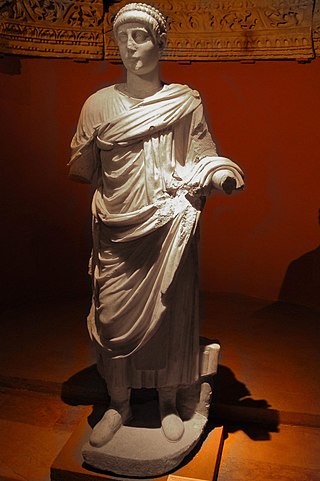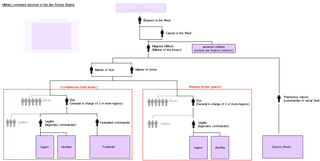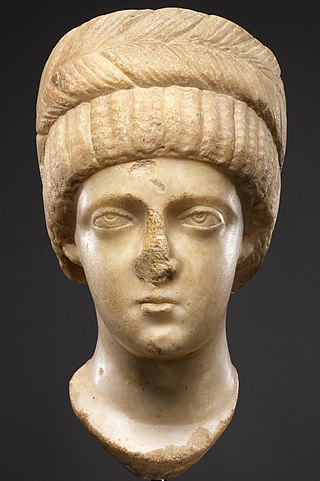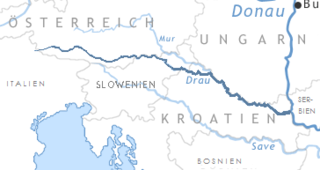Related Research Articles

Valens was Roman emperor from 364 to 378. Following a largely unremarkable military career, he was named co-emperor by his elder brother Valentinian I, who gave him the eastern half of the Roman Empire to rule. In 378, Valens was defeated and killed at the Battle of Adrianople against the invading Goths, which astonished contemporaries and marked the beginning of barbarian encroachment into Roman territory.

Year 378 (CCCLXXVIII) was a common year starting on Monday of the Julian calendar. At the time, it was known as the Year of the Consulship of Valens and Augustus. The denomination 378 for this year has been used since the early medieval period, when the Anno Domini calendar era became the prevalent method in Europe for naming years.
The 370s decade ran from January 1, 370, to December 31, 379.

Year 377 (CCCLXXVII) was a common year starting on Sunday of the Julian calendar. At the time, it was known as the Year of the Consulship of Augustus and Merobaudes. The denomination 377 for this year has been used since the early medieval period, when the Anno Domini calendar era became the prevalent method in Europe for naming years.
Fritigern was a Thervingian Gothic chieftain whose decisive victory at Adrianople during the Gothic War (376–382) led to favourable terms for the Goths when peace was made with Gratian and Theodosius I in 382.

The Battle of Adrianople, sometimes known as the Battle of Hadrianopolis, was fought between an Eastern Roman army led by the Eastern Roman Emperor Valens and Gothic rebels led by Fritigern. The battle took place in the vicinity of Adrianople, in the Roman province of Thracia. It ended with an overwhelming victory for the Goths and the death of Emperor Valens.

Gratian was emperor of the Western Roman Empire from 367 to 383. The eldest son of Valentinian I, Gratian was raised to the rank of Augustus as a child and inherited the West after his father's death in 375. He nominally shared the government with his infant half-brother Valentinian II, who was also acclaimed emperor in Pannonia on Valentinian's death. The East was ruled by his uncle Valens, who was later succeeded by Theodosius I.

Valentinian II was a Roman emperor in the western part of the Roman empire between AD 375 and 392. He was at first junior co-ruler of his brother, was then sidelined by a usurper, and only after 388 sole ruler, albeit with limited de facto powers.

Magister militum was a top-level military command used in the later Roman Empire, dating from the reign of Constantine the Great. The term referred to the senior military officer of the empire. In Greek sources, the term is translated either as strategos or as stratelates.

The Theodosian dynasty was a Roman imperial family that produced five Roman emperors during Late Antiquity, reigning over the Roman Empire from 379 to 457. The dynasty's patriarch was Theodosius the Elder, whose son Theodosius the Great was made Roman emperor in 379. Theodosius's two sons both became emperors, while his daughter married Constantius III, producing a daughter that became an empress and a son also became emperor. The dynasty of Theodosius married into, and reigned concurrently with, the ruling Valentinianic dynasty, and was succeeded by the Leonid dynasty with the accession of Leo the Great.

Aelia Flavia Flaccilla, was a Roman empress and first wife of the Roman Emperor Theodosius I. She was of Hispanian Roman descent. During her marriage to Theodosius, she gave birth to two sons – future Emperors Arcadius and Honorius – and a daughter, Aelia Pulcheria.

The Battle of the Frigidus, also called the Battle of the Frigid River, was fought on 5 and 6 September 394 between the armies of the Roman emperor Theodosius the Great and the rebel augustus Eugenius, in the eastern border of Roman Italy. Theodosius won the battle and defeated the usurpation of Eugenius and Arbogast, restoring unity to the Roman Empire. The battlefield, in the Claustra Alpium Iuliarum near the Julian Alps through which Theodosius's army had passed, was probably in the Vipava Valley – with the Frigidus River being the modern Vipava – or possibly in the valley of the Isonzo.

The Valentinianic or Valentinian dynasty was a ruling house of five generations of dynasts, including five Roman emperors during Late Antiquity, lasting nearly a hundred years from the mid fourth to the mid fifth century. They succeeded the Constantinian dynasty and reigned over the Roman Empire from 364 to 392 and from 425 to 455, with an interregnum (392–423), during which the Theodosian dynasty ruled and eventually succeeded them. The Theodosians, who intermarried into the Valentinian house, ruled concurrently in the east after 379.
Arbogastes or Arbogast was a Roman army officer of Frankish origin.

The Battle of the Save was fought in 388 between the forces of Roman usurper Magnus Maximus and the Eastern Roman Empire. Emperor Theodosius I defeated Magnus Maximus's army in battle. Later Maximus was captured and executed at Aquileia.

Between 376 and 382 the Gothic War against the Eastern Roman Empire, and in particular the Battle of Adrianople, is commonly seen as a major turning point in the history of the Roman Empire, the first of a series of events over the next century that would see the collapse of the Western Roman Empire, although its ultimate importance to the Empire's eventual fall is still debated. It was one of the many Gothic Wars with the Roman Empire.
Galla was a Roman empress as the second wife of Theodosius I. She was the daughter of Valentinian I and his second wife Justina.
Flavius Merobaudes was a Roman army officer of Frankish origin. He was appointed magister peditum around 375, and consul twice in 377 and 383. Ancient sources record that he was put to death that year for his support of the imperial usurper Magnus Maximus, but an inscription records that he became consul a third time in 388.
Flavius Saturninus was a Roman army officer and politician.
Traianus was a Roman general under Emperor Valens, with whom he died in the battle of Adrianople.
References
- Ammianus Marcellinus, History, Loeb Classical Library, translated by John C. Rolfe.
- Jones, Martindale, and Morris. Prosopography of the Later Roman Empire . (PLRE I)